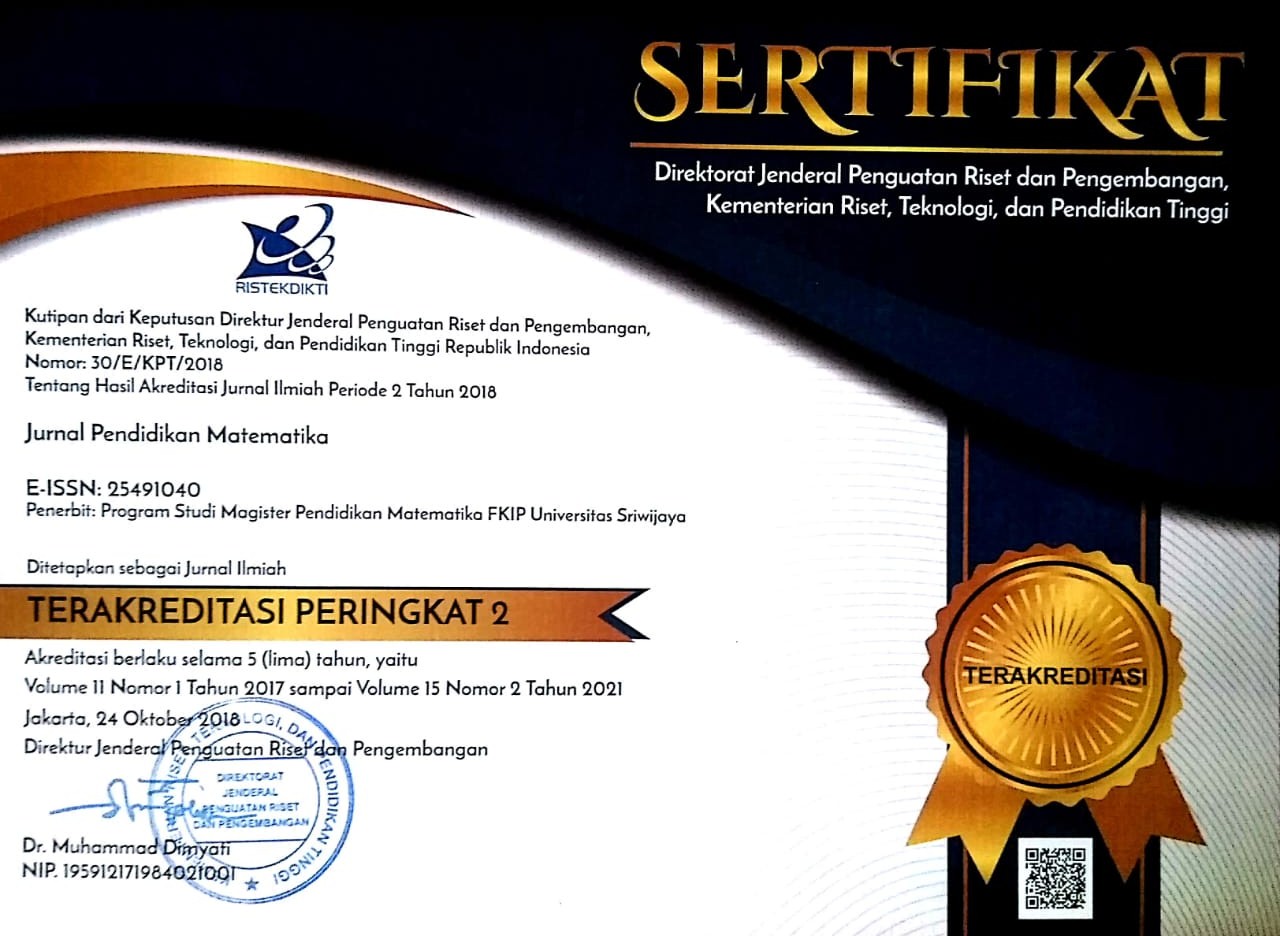Senior High School Students’ Higher Order Thinking Skills in Solving Combinatorics Problems
Abstract
Higher Order Thinking Skills (HOTS) refer to students' ability to solve problems by analyzing, evaluating, and creating. HOTS are essential for 21st century learning. Solving combinatorics problem troubleshooting requires HOTS. The aim of this research is to examine of senior high school students’ higher order thinking skills in solving combinatorics problems. This descriptive research describes the analysis of senior high school students’ higher order thinking skills in solving combinatorics problems. Class XII IPA 6 SMA Negeri 1 Trenggalek has a total of 21 students. Data was collected through a written test containing combinatorics problems and interviews. The results of the study show the senior high school students’ higher-order thinking skills in solving combinatorics problems: 38% of the students have "excellent" performance; 14% are rated as good; 10% are classified as enough; 38% are classified as low; no one is very poor. The most common indicator of higher-order thinking skills was analyzing (58%), followed by evaluating (55%). The creating rate is the lowest at 47%. This study can develop students' higher order thinking skills and evaluation for teachers in implementing higher order thinking skills in school.
Keywords
Full Text:
PDFReferences
Anderson, L. W., & Krathwohl, D. R. (2001). Taxonomy for Learning, Teaching, and Assessing A Revision of Bloom’s Taxonomy of Educational Objectives. Addison Wesley Lomman Inc.
Brookheart. (2010). How to Assess Higher-Order Thinking Skills in Your Classroom. ASCD.
Cameron, P. J. (1994). COMBINATORICS: Topics, Techniques, Algorithms. Press Syndicate of The University of Cambridge.
Dosinaeng, W. B. N. (2019). Analysis of Students’ Higher Order Thinking Skills in Solving Basic Combinatorics Problems. Math Didactic, 5(2), 133–147. https://doi.org/10.33654/math.v5i2.611
Freudenthal. (1991). Revisting Mathematics Education. Kluwer Academic Lectures.
Ginting, A. A., & Kuswandono, P. (2020). Challenges Faced by English Teachers: Implementation of Higher Order Thinking Skills (HOTS) in Designing Assignments in East Indonesia. Pedagogy : Journal of English Language Teaching, 8(1), 13. https://doi.org/10.32332/pedagogy.v8i1.1688
Gravemeijer, K. (1994). Developing Realistic Mathematics Education. Freudenthal Institute.
Hasyim, M., & Andreina, F. K. (2019). Analysis of Students’ Higher Order Thinking Skills (HOTS) in Solving Open Ended Mathematics Problems. FIBONACI, 5(1), 55–63. https://doi.org/10.24853/fbc.5.1.55-64
Kementrian Pendidikan dan Kebudayaan. (2019). Higher Order Thinking Skills Oriented Assessment Book. Direktorat Jendral Guru dan Tenaga Kependidikan.
Kwangmuang, P., Jarutkamolpong, S., Sangboonraung, W., & Daungtod, S. (2021). The development of learning innovation to enhance higher order thinking skills for students in Thailand junior high schools. Heliyon, 7(6), e07309. https://doi.org/10.1016/j.heliyon.2021.e07309
Lapuz, A. M., & Fulgencio, M. (2020). Improving the Critical Thinking Skills of Secondary School Students Using Problem-Based Learning. Online Submission, 4(1), 1–7. https://doi.org/10.5281/zenodo.3969232
Moleong, L. J. (2013). Qualitative Research Methods. Rosdakarya.
OECD. (2019). PISA 2018 Result in Focus: Combined Executive Summaries Volume I, II & III. OECD Publishing.
Prasetyani, E., Hartono, Y., & Susanti, E. (2016). Class XI Students’ Higher Order Thinking Skills in Trigonometry Problem Based Learning at SMA Negeri 18 Palembang. Gantang, 1(1), 34–44. https://doi.org/10.31629/jg.v1i1.4
R. Assaly, I., & M. Smadi, O. (2015). Using Bloom’s Taxonomy to Evaluate the Cognitive Levels of Master Class Textbook’s Questions. English Language Teaching, 8(5). https://doi.org/10.5539/elt.v8n5p100
Susanti, A., Retnaningdyah, P., Ayu, A. N. P., & Trisusana, A. (2020). Improving EFL Students’ Higher Order Thinking Skills Through Collaborative Strategic Reading in Indonesia. International Journal of Asian Education, 1(2), 43–52. https://doi.org/10.46966/ijae.v1i2.37
Tanujaya, B., Mumu, J., & Margono, G. (2017). The Relationship between Higher Order Thinking Skills and Academic Performance of Student in Mathematics Instruction. International Education Studies, 10(11), 78. https://doi.org/10.5539/ies.v10n11p78
Weiss, R. E. (2003). Designing problems to promote higher-order thinking. New Directions for Teaching and Learning, 2003(95), 25–31. https://doi.org/10.1002/tl.109
Yoke, S. K., Hasan, N. H., Jangga, R., & Mat Kamal, S. N.-I. (2015). Innovating with HOTS for the ESL Reading Class. English Language Teaching, 8(8). https://doi.org/10.5539/elt.v8n8p10
Zohar, A. (2008). Teaching thinking on a national scale: Israel’s pedagogical horizons. Thinking Skills and Creativity, 3(1), 77–81. https://doi.org/10.1016/j.tsc.2008.03.002
DOI: https://doi.org/10.22342/jpm.16.1.15121.89-102
Jl. Srijaya Negara, Bukit Besar
Palembang - 30139 Indonesia
Jurnal Pendidikan Matematika is licensed under a Creative Commons Attribution-NonCommercial-ShareAlike 4.0 International License.
Indexed in:


